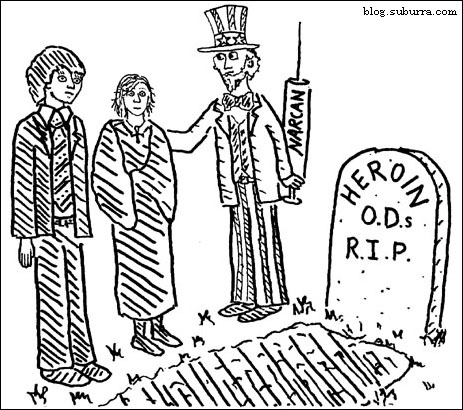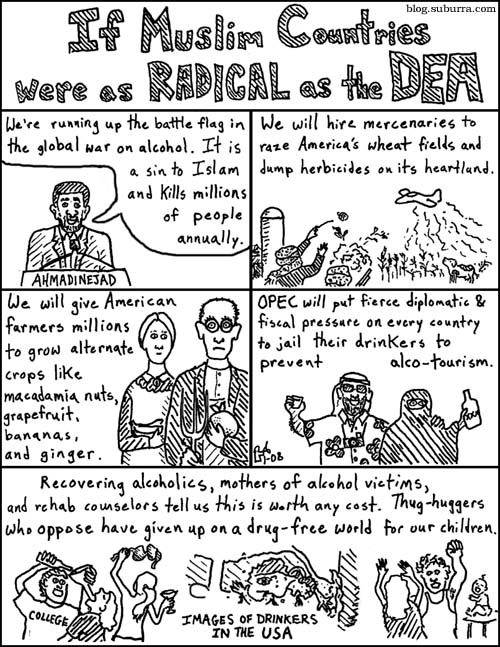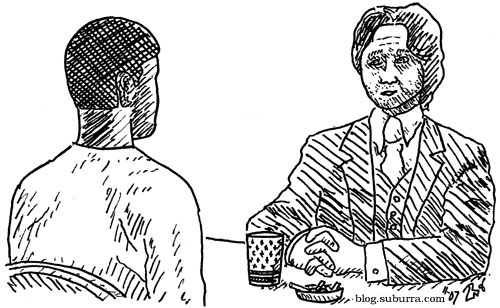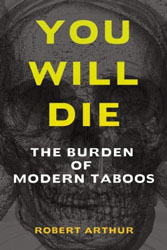Posted: April 23rd, 2008 | Filed under: drugs, heroin, legalization, opiates | 59 Comments »

Heroin Kills?
To get people to read my book I employ the common technique of teasers. Teasers for non-fiction books are often facts that will startle the reader and encourage them to find out more. None of my teasers have provoked greater skepticism, scorn, and anger than the statement, “Heroin is harmless.”
I am not naive or callous. As a public defender I frequently interviewed heroin addicts upon their incarceration. I saw firsthand these people going through withdrawal and I saw the tragedies their lives had become. However, almost all – if not all – of the damage heroin had inflicted upon these people and their families was due to the drug’s criminalization. I will explain.
Three aspects of an ingestible substance that can be considered harmful are (1) its potential to debilitate, (2) its effects on one’s health, and (3) its potential to kill via an overdose.
(1) Like the stimulants, caffeine and cocaine, heroin is not a debilitating drug. That is, moderate usage does not interfere with one’s functioning, e.g. driving ability. This is in contrast to alcohol, in which one’s performance is directly hampered. Extreme usage can interfere just like with caffeine and cocaine, e.g. too much of a stimulant can make it difficult to focus and even cause hallucinations. However, even heroin addicts can moderate their usage so that they can work unimpaired and avoid withdrawal symptoms. For this reason, heroin addicts can and do have successful professional lives in such diverse fields as surgery and law enforcement.
(2) Long-term heroin addiction is relatively harmless to one’s health. Like caffeine addicts who “need” their coffee in the morning, the side-effects are minimal. Heroin’s long-term side-effects can include constipation and impotency. This is in contrast to alcohol and tobacco which destroy the liver and the lungs respectively.
(3) Like caffeine, it is difficult to fatally overdose on heroin by itself. (It is easy to overdose when using heroin and alcohol in combination.) The popular image of a dead heroin user with the needle still in his or her arm is misleading. A fatal heroin overdose is usually a long process that takes over an hour and it can be countered within minutes by an antidote.
This antidote is Narcan. It is so tightly regulated that strict limits on its usage have caused overdose deaths even when paramedics were present. Narcan is not dangerous or addictive which leads one to believe the government wants heroin users to die. This twisted thesis is reinforced by recent comments made in light of nasally administered Narcan (LINK).
Lastly, heroin withdrawal – unlike alcohol withdrawal – is never fatal.
In many ways heroin is as harmless as caffeine and it is definitely less harmful than alcohol. Heroin has garnered the reputation of the deadliest and most evil of drugs largely due to side-effects from the War on Drugs. To learn the awesome and fascinating reality of it all, read my book, You Will Die: The Burden of Modern Taboos. For more on the safe usage of heroin devoid of moralizing read Dr. Francis Moraes’ Heroin User’s Handbook. (Moraes is a former heroin addict.)
Sources
- Robert Arthur, You Will Die: The Burden of Modern Taboos (2007). LINK
Posted: February 1st, 2008 | Filed under: cocaine, DEA, drugs, heroin | 1 Comment »

Would We Stand For It?
1. In 1982 Ronald Reagan launched his disastrous war on drugs with the words, “We’re taking down the surrender flag that has flown over so many drug efforts. We’re running up a battle flag.”
2. In 2000 there were an estimated 85,000 alcohol related deaths in the United States alone. In 2005 there were 40,000 deaths from alcohol poisoning (alcohol overdose) in Russia alone.
3. Destroying drug crops in foreign lands was an idea conceived by the Reagan administration. Reagan hired mercenaries to clear the coca fields of poor Peruvian farmers with weed whackers. This was a farce considering coca grows naturally in Peru in valleys the size of Massachusetts. America is now waging this vegetative vendetta against poppies in Afghanistan.
4. America’s next plan was to aerially dump herbicides over the South American countryside. While officially targeting coca these toxins kill all plant life – including subsistance crops – while poisoning the environment and the local residents. This technique is still used in South America as a part of Plan Colombia. Afghanistan has understandably refused to allow the United States to dump herbicides on its countryside.
5. Another part of Plan Colombia is to pay farmers to plant crops other than coca. Like the previous two tactics, this has been comically ineffective as Bolivian farmers who switched to ginger learned when they found themselves, “up to their asses in ginger,” and nobody willing to buy it.
6. America uses its full diplomatic weight and financial power to bully other countries against liberalizing their drug laws. In 2006 America stopped Mexico’s legislation to legalize small amounts of drugs with a closed door meeting. The American position was that drug liberalization by Mexico would lead to narco-tourism for Americans. (America has an officer in most major foreign embassies charged with keeping Washington informed of any liberalization of drug policies.) How much America spends to coerce other countries to keep prosecuting their citizens is rarely revealed to the American public.
7. For thousands of years opium had been smoked as medicine in South Asia and coca has been chewed for sustenance in South America with miniscule deleterious effects. However, the American media portrays Afghanistan as a cesspool of addiction due to its easy access to opium. In articles such as Newsweek’s “Flowers of Destruction” and “Harvest of Treachery” moderate use of the drug is ignored and dysfunctional addicts who constitute a microscopic percentage of the population are highlighted. (The fact that the drug war drives people to use harder versions of the drug is always ignored. This recently occurred in rural Laos where an opium crackdown precipitated by immense Western pressure drove many tribespeople to heroin.)
More on Plan Colombia can be found in a Nation article, LINK, and at Wikipedia, LINK. The ongoing billion dollar program has killed a lot of flora, provoked massive amounts of bloodshed with American provided weaponry, and caused deep American resentment. It has not affected cocaine prices in the United States.
Sources:
- “Alcohol Deaths Falling as Quality of Booze Climbs,” Moscow Times, 29 Jan. 2008. LINK courtesy of ViceSquad.
- Robert Arthur, You Will Die: The Burden of Modern Taboos (2007). LINK
- Mike Gray, Drug Crazy (1998). LINK
- Phillip Knightley, “What Went Wrong? The Drugs World War: Part Two,” Independent (London), 1 Feb. 1998.
- “Laos’s Opium Ban,” Economist, 13 Aug. 2005.
Posted: November 23rd, 2007 | Filed under: drugs, heroin, legalization, opiates | 6 Comments »

“That’s the way it is.”
American Gangster is about the New York City heroin trade in the early 1970s. It is based on the real-life adventures of heroin kingpin Frank Lucas (played by Denzel Washington), and police officer Richie Roberts (played by Russell Crowe). The American columnist, George Will, has called its humane portrayal of Lucas a “manipulation of viewers.” By accurately describing Lucas’s accomplishments Will writes that American Gangster,
entices viewers into the moral vertigo of forgetting the human carnage among users of the high-quality heroin that Lucas’s organizational skills enabled him to sell cheap.
Will then praises the movie for realistically showing the “suppurating needle sores” and the heroin addicted mothers passing out on filthy mattresses next to their sobbing babies.
Will, like those who only know heroin through mainstream media portrayals, cannot see past the needles and addicts. If Hamilton Wright had not hoodwinked the American Congress into criminalizing opiates in 1915 desperate heroin junkies would not exist. Opium would merely be smoked like it still is in numerous parts of South Asia. (Heroin is a more chemically potent form of opium.) It is the war on drugs that has forced the cost of opiates so astronomically high (see LINK) that those unfortunate enough to become addicted to it (just like with alcohol, a small percentage of total users LINK) cannot afford to lose any of it through the smoking process. Because of this, they must inject it directly into their veins.
Whereas Will thought American Gangster was manipulative in portraying a drug dealer as a human being, the actual manipulation occurred with the multiple gratuitous shots of needles hitting home. Lucas’s commitment to pure product, his “Blue Magic” brand, could enable people to smoke heroin and avoid the debilitating effects of injecting heroin cut with a potpourri of street substances. (Regular heroin usage is actually physically harmless. It is the side-effects of criminalization that make it dangerous. LINK)
It would also be interesting to know if Richie Roberts’ partner actually died of heroin overdose or if it was a “morality lesson” added to the script. (Apparently a lot was added. LINK) Movies and television regularly kill every heroin using character with an OD despite the mathematical absurdity of this.
In the movie, Roberts says to Lucas:
I got hundreds of parents of dead kids, addicts who ODed on your product and that’s my story for the jury. That’s how I make it all stick. This man murdered thousands of people and he did it from a penthouse driving a Lincoln.
Only someone who believes the heroin death rate portrayed on television and in the movies can hear the “thousands of people” line without laughing. In 2003 it is unlikely even 4,000 people died of any type of opiate overdose (e.g. heroin, morphine, OxyContin) in the entire country. When Nixon was declaring that drugs were a national emergency in the early 1970s more Americans were dying from choking on food or falling down stairs than from illegal drugs.
Politicians and government bureaucrats could save thousands of lives by ending the inane drug war that declares otherwise law-abiding drug users and drug dealers as public enemies. Legalizing heroin would make heroin overdoses as rare as alcohol overdoses. Legalizing would also end the countless deaths caused by drug turf wars. Whereas the government could make a difference, Lucas could not. As Lucas and Roberts discuss in the movie:
Lucas: Do you really think that putting me behind bars is going to change anything on the streets? Them dope fiends are gonna steal it. They gonna steal for it. They gonna die for it. Putting me in or out ain’t gonna change a thing.
Roberts: Then that’s the way it is.
Lucas: That’s the way it is.
Sources:
- Robert Arthur, You Will Die: The Burden of Modern Taboos (2007). LINK
- George Will, “Another Mob Hit,” 8 Nov. 2007. LINK





